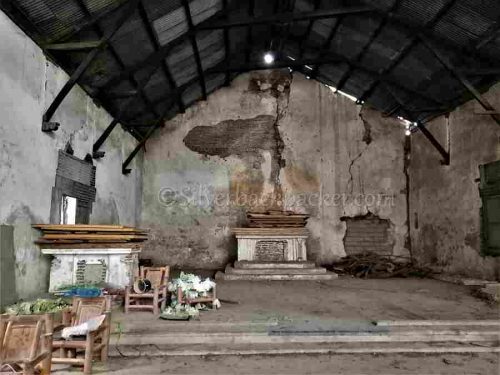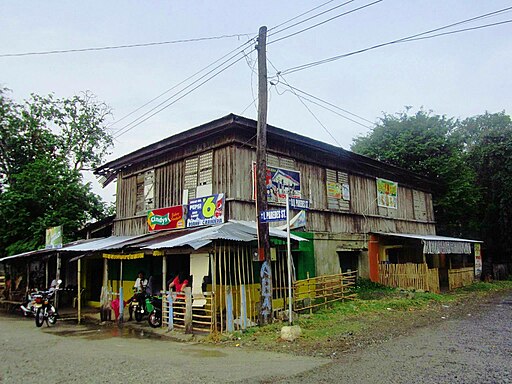Pidigan's Forgotten Heritage
Cultural Properties of Pidigan, Abra
Heritage of Pidigan
Origins and Heritage of Pidigan
The origin of the name “Pidigan” is not well known. Some old people of the municipality say that at first, the site of the Poblacion was once called “Bantay Lugnac”. Later, the name changed to “Pidpideg”, which over time evolved into Pidigan.
It was called Pidpideg because a group of people sailed down the Abra river in bamboo rafts and were brought close to the rocks that line the riverbanks by the swift current. Describing the event, the word Pidpideg came about, an Ilocano term which means “forced close against”.
The first people who inhabited Pidigan were Tingguians. Most of them lived in the villages of San Diego, Sideg, Sucyo and Caburao. At the time, Pidigan was a dense forest with wildlife that sustained the people.
Originally, Pidigan had 5 barangays. They were: Arab, Induyong, Caburao, Pamutic and San Diego. In an attempt to enhance the economic, social and cultural well-being of the people, the municipality was divided into 15 barangays in 1969.
Today, the barangays are:- Alinaya, Arab, Poblacion East, Garreta, Immuli, Laskig, Monggoc, Naguirayan, Pamutic, Pangtud, San Diego, Sulbec, Suyo, West Poblacion and Yuyeng.
What is a Cultural Property in the Philippines?
The Philippine Registry of Cultural Property (PRECUP) is the repository of all information pertaining to cultural properties in the Philippines deemed significant to our cultural heritage. It was established through Article V Section 4 of Republic Act 10066 or the National Heritage Act of 2009.
With the ratification of the National Heritage Act of 2009 or RA 10077, structures over 50 years old are considered “Important Cultural Properties” unless declared otherwise by the National Historical Commission of the Philippines. An Important Cultural Property refers to a cultural property having exceptional cultural, artistic, and historical significance to the Philippines and which shall be given among others priority government funding for its protection, conservation, and or restoration.
List of Cultural Properties of Pidigan
A list of the Cultural Properties in Pidigan, Abra as listed with the NCCA
- Immaculate Conception Church. The Old Church. 17.570712°N 120.589175°E
- St. Mary High School, 17.570749°N 120.589731°E
- Jerimias Bringas Ancestral House Ruins, 17.56959°N 120.590578°E
- Paaralan Sentral ng Pidigan / Pidigan Central School, 17.569531°N 120.590068°E
- Figueras Ancestral House, 17.569944°N 120.590101°E

Mayor Jeremias Bringas House (Temporary Provincial Capitol)
The Spanish built red brick house of former Municipal Mayor Jeremias Bringas (1925 – 1928) When Liberation came in 1945, Pidigan was made the temporary seat of the Provincial Government of Abra, while the American bombed Capitol in Bangued was being rebuilt.
The house of Ex-Mayor Jeremias Bringas was used as the Provincial Capitol with Atty. Zacarias Crispin as Military Governor and Mr. Emilio Bringas as appointed Military Mayor up to September 1945. Today, the grand-daughter of Jeremias Bringas is caretaker of the house ruins. A store has been built in front of the old building blocking its view from the road.





Sinforoso Figueras Ancestral House
Sinforoso Figueras, was the first Municipal Mayor of Pidigan from 1913 to 1919 and again from 1943 to 1945 during the Japanese occupation of the town. Today it is used as a Sari Sari store. On January 1, 1913, the municipality of Pidigan was organized.
The first mayor and vice mayor were Sinforoso Figueras and Clemente Plastina, respectively. On January 4, 1913, the first resolution of the municipal council was to organize the Municipal Police Force of Pidigan with Rosendo Farrales as first Chief of Police. After the organization of the municipality of Pidigan on January 1, 1913, the persons who served as municipal mayors were: Sinforoso Figueras (1913-1919), Mamerto Bugtong (1919-1922), Tomas Perez (1922-1925), Jeremias Bringas (1925-1931), Felipe Pariñas (1931-1940) and Felix Bringas (1941-1943).
During the outbreak of World War II, Pidigan was among the garrison centers of the Japanese Imperial Forces in Abra. The Japanese forces used school buildings and private large houses as barracks. At the time, Felix Bringas was the incumbent mayor. With the coming of the Japanese, Sinforoso Figueras was installed as mayor from 1943 to 1945.

Old church of the Immaculada Concepción
Old Pidigan Church, Heritage of Pidigan
Classified Historic Structures (covering all Colonial Churches and other Houses of Worship, per NHCP Res. No. 3, s. 1991)
This church caught fire at Christmas 1879 and was burnt down. Reconstructed by Fr. Jose Foj using bricks, the church had a cogon roof. Another fire destroyed this church, and once again Fr. Foj rebuilt the church before leaving Pidigan in 1884.






Agustinian Friars worked in Pidigan until the Revolution when they all had to leave Abra. The last Agustinian Friar, Fr. P Juan Arrate, arrived in 1894 staying for four years until the revolution. Pidigan then stayed without a priest until 1901 when Fr. Higinio Payinyo arrived to the Parish.
Pidigan was turned over to the SVD in 1919, when Fr. Teodoro Schindler arrived. In 1934 Fr. Aurelio Galvan became the Parish priest. He installed a narra altarpiece (retablo) which was later transferred to the church in San Quintin.

*** Two of the old Altars still remain and are in quite good condition. The roof and walls do need some considerable restoration. The building is currently being used as a soft drinks warehouse.
St Mary’s High School, Pidigan
The School opened on 5th December 1921 in the house of Agapito Perlas and at first was called the Immaculate Conception Elementary School after the Patroness of the Parish . After the restoration of the convent by Fr Herman Wilhelms in 1924, the school moved to the two floor convent, with the accommodation of the Nuns on the first floor and the school on the ground floor.
The convent was bombed and destroyed by the Americans during WW2, and rebuilt by Fr.Luis Meissner in 1949 and became known as St. Mary’s High School.
This is the school we see today.



Pidigan Central School Gabaldon Building
Pidigan’s Gabaldon school building was built in 1921 and is a Heritage of Pidigan. In 2019 restoration work was started on it. The Gabaldon school buildings built during the first decades of the American colonial rule followed a standard design made by Architect William Parsons and funded through Act Number 1801 by Isauro Gabaldon, after whom the school buildings are named.
Gabaldon was a member of the Philippine Assembly from 1907-1911. Act 1801 stipulated the construction of school buildings in barrios or barangays with a daily attendance of at least sixty students. These school buildings were later called the Gabaldon School houses or simply the Gabaldons. President Duterte on Jan. 18, 2019 signed the Republic Act 11194, which seeks to preserve the architectural, historical and social significance of Gabaldon school buildings, and heritage school houses built in the Philippines from 1907 to 1946.
Local government units that have Gabaldon school buildings under their jurisdiction shall likewise adopt measures for the protection and conservation of these structures and shall aid DepEd in conservation efforts.


Summary
Pidigan has many other buildings that could be classed a a Heritage building, such as the IFI Church, Ancestral Houses around town, and even the Municipal Hall. Pidigan needs someone who can take charge and run a Heritage Society to preserve its historical buildings.
The buildings already listed need preserving for future generations who will be ignorant of their past if these aren’t taken care of now.
Pidigan, Don’t let your Heritage die.
*** Old Pidigan images from SVD Golden Jubilee Booklet courtesy of Banguedenio

Essential Travel Guides
Lost Heritage of Pidigan,
Abra
Philippines
Related Posts you may like to Read
Historical Markers of Abra
The Tabungaw Hat Maker
Historical Markers and Monuments of Antique
Open and Find Out How to travel to Abra
How to travel to Abra from Manila
By Bus
- From Metro Manila, there are three bus companies operating along the Manila to Bangued route. Partas Bus Company, Viron Transit and Dominion Bus Lines.
- Journey time is around 10 hours
- Fare at time of writing is P600
Bus Companies that link Bangued with other destinations are
Bangued to Manila, Baguio – Partas Bus Company Bangued to Manila, Baguio – Dominion Bus Lines Bangued to Baguio – Sambrano Bus Lines Bangued to Manila – Viron Transit Bangued to Vigan, Tuguegarao – Esonice Bus Lines Bangued to Baguio, Vigan, Laoag – BBL Transit By Air There are no airports in Abra. The closest airport is Laoag, three hours away by car.
- Cebu Pacific and Philippine Airlines have daily flights to Laoag.
- From Laoag take a bus to Vigan and change there for a bus to Bangued
- Or take any bus that is heading south and alight at Narvacan for bus and jeepney connections to Bangued
Bangued to Pidigan
Buses and jeepneys pass by the Pidigan junction, which is about 25 minutes from Bangued. Just ask any tricycle driver to take you to the Pidigan terminal.
There are tricycles waiting at both entrances to Pidigan.
By Car or Motorbike
Pidigan is just off the Ilocos Sur road around 7km from Bangued.
PIN to Read Later

Did you like “Cultural Properties of Pidigan, Abra” ? If so then please share this page with your friends.
Leave a comment below to let me know what you liked best.
Follow Silverbackpacker on Facebook, Instagram ,Twitter and Pinterest for more travel adventures and be notified about my latest posts and updates!
Thankyou for sharing 🙂
PIN to Read Later

TRAVEL RESOURCES
SEE MORE
Follow Silverbackpacker for more of his Travels
Facebook @silverbackpacker | Instagram @silverbackpacker Twitter @silverbackpaker | Pinterest @silverbackpaker Audere Est Facere – Silverbackpacker.com – To Dare is To Do Affiliate Disclaimer: Links on this website may be affiliate links that could result in us receiving compensation when you purchase a product or service from that link. You do not pay any extra fees for these items. This helps us to keep this website going. Thank you for your support. Disclaimer | Privacy Policy | All Rights Reserved


